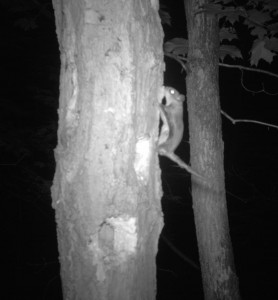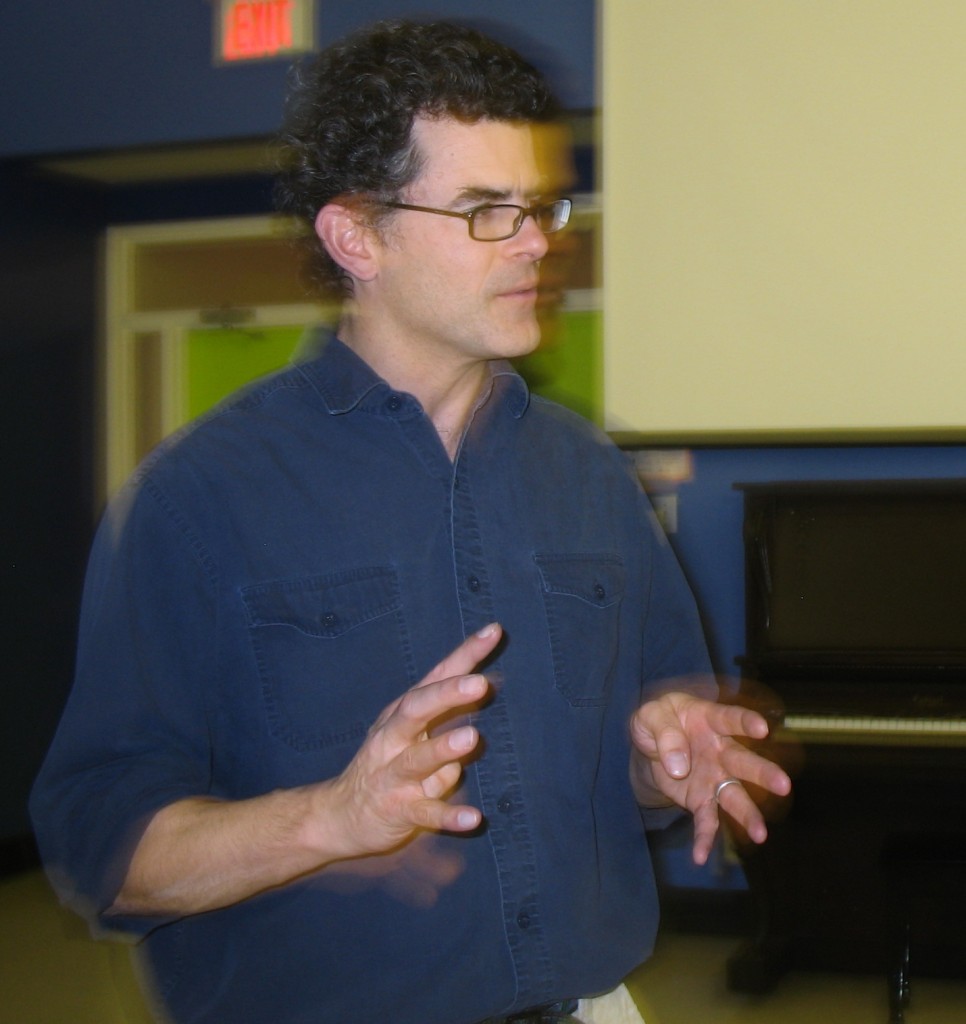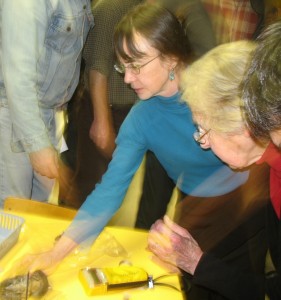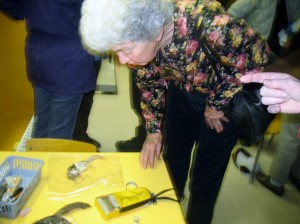Two species of flying squirrels survive winter in our forests: a report of the November 2011 MVFN lecture, written by Pauline Donaldson
As I arrived at the social hall of Almonte United church for the third lecture in the Mississippi Valley Field Naturalists (MVFN) natural history lecture series, I noticed the audience was larger than usual and there were several new faces. I was not surprised though, because the subject of the evening’s lecture was to be the mysterious (seldom seen) nocturnal rodent— the flying squirrel.
From our expert guest speaker, Trent University adjunct Professor Dr. Jeff Bowman, a senior scientist with the Ontario Ministry of Natural Resources, we would learn that flying squirrels are beautiful and useful creatures and that without them our lives and forests would lose many values. As the lecture gets underway we learn there are more than 40 species of flying squirrels worldwide, including the cave-dwelling woolly flying squirrel of Pakistan which survives solely on a diet of pine needles. However, Dr. Bowman has come to talk to us about the only two species of flying squirrel found in North America. These flying squirrels are relatively rare and are adapted in many ways to our boreal and temperate forests.
A southern flying squirrel, foraging at night, is photographed by a remote, infra-red camera. Both the Northern and Southern Flying Squirrel are strictly nocturnal and therefore are seldom seen. Photo courtesy Jeff Bowman
In most places in North America one finds only one species of flying squirrel, either the Northern Flying Squirrel (Glaucomys sabrinus) or the Southern Flying Squirrel (Glaucomys volans). Since their ranges overlap in our area, we have both kinds here. These two flying squirrels do have distinct habitat and resource requirements though, and this is something Dr. Bowman and his research team study. Since flying squirrels are nocturnal, many people have never seen one, or have only caught glimpses of one in the town or country, scrambling at their bird feeder, or unfortunately sometimes in the jaws of their cat. Some do find their way into people’s houses too. Outdoors, acorns with large holes bored into them can be evidence of their presence.
The Southern and Northern Flying Squirrels are similar, with brownish/ greyish backs, light white/cream bellies and large eyes characteristic of nocturnal animals. The Southern flying squirrel, at ~ 65 grams or about chipmunk-sized, is smaller than the Northern species, which is closer in size to the red squirrel. As far as flying goes, they really only glide: a large patagium or fold of skin, between their wrists and ankles acts like a parachute as they take off with their legs stretched wide apart. They glide, resembling little furry pancakes (albeit a little square), from one place to another using their tails to steer. Flying pancakes in our maple sugar bushes! The ‘flying’ mechanism of flying squirrels and of unrelated marsupial mammals such as the feather-tailed possums of Australia evolved in a similar way. As Dr. Bowman explains, this is an example of convergent evolution.
A short way into the presentation, we watched a video taken by Dr. Bowman: a small southern flying squirrel sits up, its large eyes staring. He/she appears to be chattering at us, but we hardly hear a sound. Dr. Bowman explains that his audio recorder captured sounds in a frequency barely audible to humans. Like humans and many animals they make many sounds at different frequencies and in different situations (e.g. chittering, chortling, chuck chucking, seeping etc.), some at ultrasonic frequencies which are inaudible to us and to barred owls, one of their predators (other predators are other owls, fishers and martens). Whatever they are saying we can’t listen in, so for now we are happy to have Dr. Bowman speak on behalf of these creatures which he has studied for many years.
Flying squirrels do not hibernate and so have a particular challenge to survive the forest winter without putting on weight which would compromise their ‘flying’ ability. They have a number of strategies for this. One is brown fat which can give high energy and heat with little mass and another is to stockpile or cache foods (especially nuts in the case of the Southern species, or lichen for the Northern). Another key strategy is social nesting for thermoregulation; in winter they sleep in groups in nests made mainly in the cavities of trees. The requirement for group nesting may dictate other minimum habitat requirements for flying squirrels, so Dr. Bowman and his graduate students have made the study of social nesting behaviour a priority. How many nest together, how are they related and where do they nest, they wondered? They set about their investigation aided by various instruments: very tiny injectable transponders with ‘scannable’ ID tags, tiny radio collars to locate some animals at a distance (these they take off a few weeks later), and datalogger stations to install temporarily at trees with active nests to track the comings and goings of the tagged individuals— with really fascinating results!
The flying squirrels need to co-nest with a critical number of ‘friends’ in order to survive winter and this could be only a few individuals, or at times up to 20 or more squirrels sharing a nest. But do the same individuals nest together each night? The answer is yes. However, they do not nesting with close relatives or kin. Rather, the nest-mates are unrelated individuals with summer foraging territories close to one another. Although they co-nest, they forage alone both winter and summer. Another thing the researchers discovered was that nest sites were abandoned surprisingly often. This may be to avoid parasite problems which can occur in the nest (despite their use of cedar in the nest lining materials). When nests were abandoned and the researchers finally located the newest nest site, to their surprise they always found the same gang of individuals huddled together in the nest.
Dr. Bowman’s research work is contributing to a better understanding of the habitat requirements of flying squirrels, and their role in forest ecology. There are 1-2 flying squirrels per hectare, and it seems that a woodlot of at least 22 hectares is needed to support enough individuals for social nesting. Numbers of flying squirrels and other small mammals vary according to the nut density in the woodland, and all are affected by forest fragmentation. The Northern Flying Squirrel in particular is a good indicator species for old mature forests and they are particularly susceptible to forest fragmentation. A major component of the Northern Flying Squirrel’s diet is a fungi found only on the roots of spruce trees. This symbiotic mycorhizzal fungus is essential for the health of the trees since it carries nitrogen-fixing bacteria. By eating the fungus the squirrel helps spread the fungal spores to other trees.
Dr. Jeff Bowman of OMNR and Trent University, guest speaker for our talk on flying squirrels. Photo Pauline Donaldson
Following the talk on Flying Squirrels, participants examine exhibits provided by Dr.Bowman. Photo Pauline Donaldson
The research work is also giving insight into how a changing climate might affect flying squirrel populations. We are at the northern limit of the Southern species range. Dr. Bowman explained that as warmer temperatures shift north, the area of overlap between the Northern and Southern species is also expected to shift, although the impact of a parasite which affects the southern species is difficult to predict since it may or may not move north. In 2003, the northern limit of the southern species was 240 km further north than usual because of warm temperatures. The next year when temperatures dropped and food supply declined, the boundary moved sharply southward. The trend thought seems to be that the Southern Flying Squirrels are on the move; moving north into the range of the Northern Flying Squirrel with interesting effects. At the contact zone apparently 4% of flying squirrels are fertile hybrids, apparently an example of climate change induced hybridization. This new finding is important but little is yet known of the biology and behaviour of the hybrids and how well they may adapt to changing habitats or climate. Will this hybridization between species eventually lead to a decreased diversity or even species extinction for the flying squirrels?








